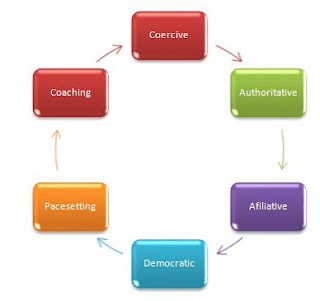A leadership style builds the
climate in an organization and a leader is responsible for quality of
organization climate which in turn account for about one third of profitability
and productivity.
A person behavioral and emotional
intelligence aspect has plays a vital role in one's leadership attitude when leading and
dealing with people?
Six kind of leadership can be
observed. Following is the circle of leadership style .
Different scenario have
diverse need of leadership . A leader is in center of this circle where he/she
needs to carefully pick the leadership style as per need of time.
Let’s explore what kind of
approach or attribute a leadership style has, in what situation it is going to
be more effective and when it can cause bad results.
Approach: DO-WHAT- I-SAY or My way or high way
Effectiveness Situation:
It is effective only in
turnaround scenario, while making tough decision like firing and dealing with
problem employee with whom everything else has failed or in natural disaster
like tsunami , fire etc. A leader has complete control on situation.
Do not use in long overhaul
and MUST not be practices once crisis is over.
Drawback:
What if one continue to stuck
with coercive style.
This top down decision making
may force employee not to bring new ideas as they thought that it will be
killed at first shot. Attitude of just-follow-order will be developed in people
. This will kill innovation. Morale will be down and people will
stop taking initiative.
Overall negative impact on
organization climate .

Approach: COME-WITH-ME
Destination is told but how to
reach there is people decision.
This style provide the vision
and making clear to people how their work is useful and how it matters to
company and why.
Effectiveness Scenario:
As it is people decision on
how to achieve goal , it makes them innovative and motivate for calculates
risk. Useful when organization is moving aimlessly and missing or confusing
vision and strategy. Authoritative leader provide direction to people . People
get motivated and work for one mission which increase productivity. Overall very positive impact on organization
climate.
Drawback:
If
working with team members who are more experienced then leader, people can
think of leader as self-important and with excessive self-esteem.

Approach: PEOPLE-COME-FIRST
People
are more important than tasks & goals. Theses style leaders build the
emotional bonding and reap it for productivity.
Effectiveness scenario:
If
you are assigned a team with low trust and weary, Affiliative leadership build
trust, bring harmony and energize the
people. It is used when team building is needed.
Drawback:
Affilitaive leaders do not provide constructive advice on how
to improve and leave employee to figure out the way. When people need
directives , affiliative leadership do not provide any navigation. As it has less
focus on task, poor performance can go unnoticed or overlooked.

Approach: WHAT-DO-YOU-THINK
Making
decision collectively . Having consensus among people.
Effectiveness Scenario:
Consider
that you own a shop and you need to close down it .
There
are two ways , just tell the decision , this will cause panic and legal action against
organization.
Other
is call all employee discuss facts , take their view and build consensus to
close down . People will understand the situation and will collaborate and
trust will be maintained.
Very
helping when leader is uncertain and need expert advice.
Drawback:
It can
cause series of meeting with no results .If people are not competent to provide
decision making advice.
Approach: DO-AS-I-DO
Sets very high standard and
exemplify himself. Pinpoints poor performance and ask to put more effort.
Effectiveness Scenario:
When need to achieve business
results quickly e.g. to gain market share by introducing new products before
competitors. Organization will have a high energy group people for a short time
period with very high productivity and quality of work.
Drawbacks:
People are overwhelmed by demand . Put team in continuous stress
which bring the morale down.
Work become task oriented and
so routinely that it become boring. It could bring unhealthy competition to get
leader attention by people.
Approach: LET-ME-DEVELOP-YOU
Leader identify people skill
set , strength & weakness to develop him/her.
Effectiveness Scenario:
The coaching leadership style
is most effective when the employees are receptive to this help. Build a
environment where people are happy to share the knowledge and are open to
feedbacks.
This will increase
productivity as employee’s personal aspiration , long term goals &
organization objectives go together.
Drawbacks:
It fails if employee do not want to learn or is not interested
in change his or her way and attitude.
To get more of this style a learning atmosphere is needed .

Ø http://www.money-zine.com/Career-Development/Leadership-Skill/
Ø http://www.eqleader.net/
Ø HBR On Managing People
Ø http://www.managerssuccess.com


























